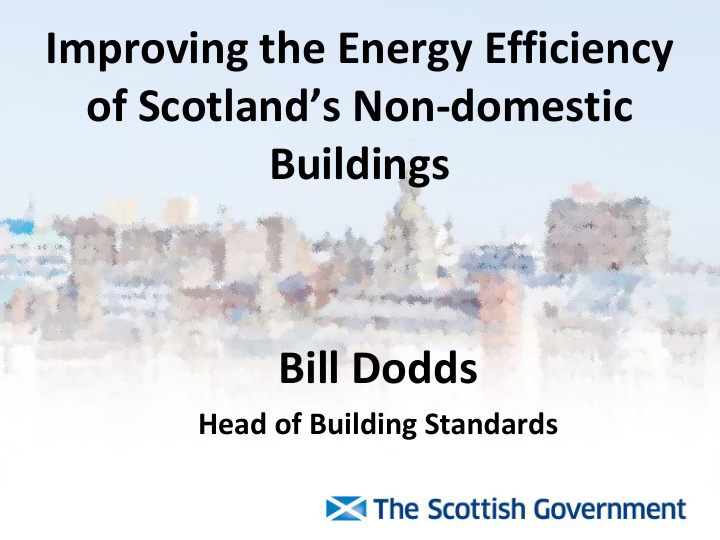



Improving the Energy Efficiency of Scotland’s Non-domestic Buildings Bill Dodds Head of Building Standards
Policy Background • … back in 2008. • Previous action on improvement within building regulations • Section 63 of The Climate Change (Scotland) Act 2009 • Other similar policy work and Scotland’s Energy Efficiency Programme
63. Non-domestic buildings: assessment of energy performance and emissions (1) The Scottish Ministers must, by regulations — (a) provide for the assessment of — (i) the energy performance of non-domestic buildings; (ii) the emission of greenhouse gases produced by or otherwise associated with such buildings or with activities carried out in such buildings; (b) require owners of such buildings to take steps, identified by such assessments, to — (i) improve the energy performance of such buildings; (ii) reduce such emissions.
New Regulations • ‘The Assessment of Energy Performance of Non-domestic Buildings (Scotland) Regulations 2016 ’ – the first step • Follows the same initial approach as Energy Performance Certificates (EPCs) • Dual duty on owner to provide information (trigger of sale or rental to new tenant) then to ‘improve’ or ‘report’
What happens? • >1,000 m² floor area + other exemptions, builds on EPC assessment (uses EPC data) • Assessment - Software applies prescribed improvement measures to create modest energy and emissions targets. • Advice – new Section 63 Advisor role to discuss and agree improvement measures • Separate Display Energy Certificate Assessor role
Action Plan • Records improvement targets and the measures proposed to meet them • Sets timescale for completion of work • Notes if owner will improve or defer work by reporting operational ratings • If improving – 3.5 years allowed • Option to defer/report must start in year 1
Action Plan
Display Energy Certificate • Defer improvement by annual reporting • Standard UK Display Energy Certificate (DEC)and existing DEC assessor role • Option for asset-only DEC in year 1; advisory Report not mandatory for s.63 • Wider use of DECs + AR – e.g. ESOS • All data lodged to register and accessible
Roles and Responsibilities As with all new things, the need for all parties involved to understand and carry out their part of that process. • Initial and ongoing duty of the owner • Function of the Approved Organisation • Responsibility of the advisor/assessor in preparing an Action Plan or DEC
Tools, Skills & Information • iSBEM Action Plan tool implemented Nov 2015, but no FI-SBEM/DSM tools yet • Register systems live August 2016 • New advisor role suited to existing construction professionals • Develop existing resources to assist in assessment and advice
Current Activity • Continue to publish policy guidance and supporting documents • Work with Approved Organisations to implement & further develop the new Assessor and Advisor roles • Develop sectorial advice, with industry • Clarify likely next steps for regulations
The seven measures which are applied to set the improvement target are : 1. Draught-stripping windows and doors If air infiltration rate is higher than 14 m³ /h/m², apply draught-stripping to windows and doors measure applied. Improvement target will be based upon a infiltration rate reduced by 10%. 2. Upgrading lighting controls to manual and photoelectric switching If there are no lighting controls in the actual building, lighting controls measure are applied. Improvement target will be based upon presence of occupancy sensors and photoelectric switching. 3. Adding central time heating controls to the Heating, Ventilation and Air Conditioning (HVAC) system If there is an incomplete set of heating controls present in the building, central time heating controls are applied. Improvement target will be based upon presence of missing measure(s), to improve heating efficiency by 1%. 4. Adding insulation to the hot-water storage cylinder If a hot water tank is present and no insulation jacket specified, an insulation jacket round hot water tank will be applied. Improvement target will be based upon 80 mm jacket to hot water storage cylinder. 5. Replacing incandescent lamps with compact fluorescent lamps If incandescent lamps are recorded in the lighting specification in any zone, a lamp replacement measure is applied. Improvement target will be based upon presence of Compact Fluorescent Lighting (CFLs) in all relevant zones. 6. Insulating accessible roof space If any roof is poorly insulated (a U-value poorer than 1.0 W/m²K) and the roof space is accessible, apply a roof insulation measure to each such zone. Improvement target will be based upon an improved U-value to 0.15 W/m²K. 7. Replacing the boiler if it is older than 15 years If any boiler present is more than 15 years old, apply a boiler replacement measure. Improvement target will be based upon new boiler of same fuel with efficiency equivalent to the minimum value set out in the building regulations.
Questions? For further information, see: www.gov.scot/section63
Recommend
More recommend